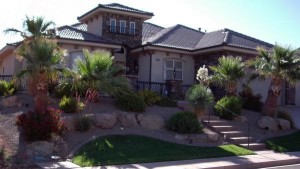Jul
Summer Maintenance for Your California and Arizona Sod
For those of us in the desert areas we’re just about to monsoon season. For many this is a welcome relief from the heat and your lawn agrees. While warm season grasses love hot weather for growing, they thrive when there is humidity in the air. I realize the desert regions aren’t like the south with 90% humidity but 105 degrees and 25% humidity are pretty nice for a warm season lawn. With humidity comes a little maintenance. Similar to trimming your trees prior to heavy monsoon winds, grass does better when it is thinned out. Today I’m going to give you a couple different ways to manage your warm season lawn.
Every lawn has new growth coming from the crown down below looking to get to the surface. Often times its blocked by the older leaves that don’t allow it to grow through and flourish. What do you do to establish your new growth? For the residential market its easy to rent a power rake from your local equipment rental store or Home Depot. This machine opens up the turf canopy and thins out the plant and thatch layer. Be careful not to set this too low and dig out too much thatch. It is beneficial to have between ½” and ¾” of thatch. Anymore than that keeps water and air from reaching the soil and can be a breeding ground for insects and possible disease. This machine will help you remove layers of dead grass and roots allowing for better water infiltration.
One sign your lawn has too much thatch is needing to use more water than normal. Dig out a piece of your lawn with a shovel and measure the thatch layer. Thatch is the layer between the soil and crown of the plant. This will be very easy to see if you dig out a shovel sized sample.
Another common practice is aeration. The nice thing about doing this during the humid time of the year is the ground doesn’t lose moisture quite as quickly as it does in June when the weather is hot and dry. Knowing when to aerify your lawn can be a little bit tricky but a general rule of thumb is to do so every other year. This will prevent soil compaction and allow your roots to grow deeper into the soil.
When a soil is compacted the roots will often stay in the top few inches of the soil resulting in a plant that isn’t as heat or cold tolerant as one with a solid root system. Often times people realize their lawn is compacted when water is running off the soil surface. No one wants to waste water and its also not healthy for the plant not to be able to take up water from the soil.
Having a company come out and aerify your lawn is quick and easy. The plugs don’t need to be removed from the surface and the holes don’t need to be filled in. You can simply mow or mulch up the plugs next time you mow the lawn. Be a little careful as a newly aerified lawn will dry out faster than normal for the first few days but it will quickly fill in the gaps and return to normal. Aerifying is an essential practice to maintaining a great lawn and saving water.
- Quick top growth or grow in to cover voids – ammonium sulfate 21-0-0 at 5 pounds per 1000 SF.
- Maintenance fertilizer – 21-7-14 or 15-15-15 every 4-5 weeks during the growing season
- Pasaplum recovery – Kelplex or half rate of 15-15-15
- Starter Fertilizer – Soil Burst 4-4-2
If you have any questions pleased let me know.
Jay


